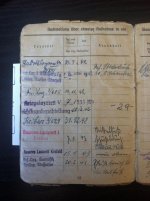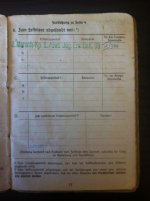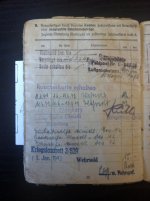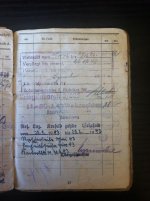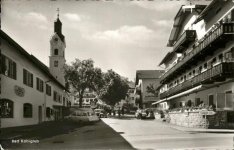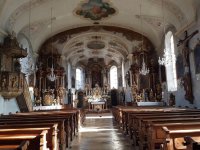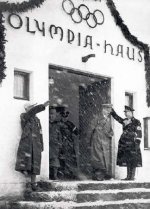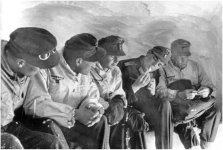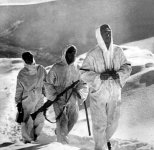And this is what I see in the document:
It comes with a signed picture of him in civil clothes, (I guess added after 1944). Note the green ink stamps and writing of Gebirgsjäger units.
He was born in 1921 in Bad Kohlgrub, about 30 kms. to the north of Garmisch Partenkirchen. City chosen to host the 1936 Olympic winter games. He was about 18 when the war began and 20 when he joined the Army. The pictures on this post are from Bad Kohlgrub and others from the 1936 winter Olympic games in Garmisch.
The 1 Geb Div was created in 1938 in Garmisch Partenkirchen from mainly Bavarian men and some Austrian also. It was considered an Elite Division.
His father, Josef Mayr had a Coffee Bar in Bad Kohlgrub, probably Georg and his Mother, also worked there. I had a look in google maps and in Bad Kohlgrub there is a little local business that has a grouping of holiday houses for hire under the name of “Georg Mayr”, the surname Mayr is not uncommon in that area, maybe related to him, but who knows…
In page number one, his rank promotions, after Gefreiter and Obergefreiter, he was chosen for R.U.B. (Reserve Unteroffizier Bewerbe), these were soldiers chosen by the officers as candidates for NCOs. He went to the NCO school for Gebirgsjäger in Wörgl and returned to the front as Oberjäger, (NCO equivalent to Unteroffizier). This is the last entry on 29 Nov. 1944.
I can not read what it says for proffesion (stand, beruf), First “Ld”, which could be “led.” or ledig (single, not married), sometimes they put this before the occupation. And then, I am quite sure of the first 4 letters “Kano” an then “litol” “lital”?, don´t know what that means.
So the young Georg left his quiet village and joined the army as a Gebirgsjäger in Feb. of 1.941 or before, his unit was the same through almost the whole war, 1st Batl. 99th Reg. 1st Gebirgsjäger Div.
Some weapons and equipment entries are noted just one week before Barbarossa Operation. A BSW 38 K98k was issued to him (not a common code) and a bajonett, with the code “Corts”. Probably Jos Corts 1938?. Also a Reinigungsgerät 34 for the rifle, a gas mask with other things there that I don´t know, like “1 Feldfill”? “4 Losandin”, maybe some medicine pills. He received other Gebirgsjäger items, clothing, boots, etc…
So I will go with his hospital visits, awards and some of his Regiment facts chronologically:
I guess he received the equipment entries when he had already done his instruction and practice as a Gebirgsjäger.
His regiment had been fighting in Yugoslavia in April 1941. Later the regiment was transported to Poland and until 20/06/41 they were in Poland preparing for Barbarossa, that is when I guess he joined the Regiment.
The 1 Geb. Div. was integrated in Army Group South, under command of Feldmarshal Gerd von Rundstedt.
The Infantry Assault badge in Silver was on 1/8/41. At this time the Russians were retreating in the area. On the 2/8/41 the regiment reunited on Ternowka with the 9th Panzer Div. and the 4th Geb.Div. encircling soviet units. The Regiment continued further combats and advances deeper into Russia.
Hospital visits first entry 30/5/42 with no description. Georg was doing not too bad managing to stay healthy for almost 1 year in the Eastern front. Just 1 day in Lazarett. (Around this time the 1 Geb. Div. is part of operation “Fall Blau” intended to take the Caucasus oil fields).
Then Iron cross 2º Class on 4/6/42. I can´t read the explanation…
Next Lazarett entry, 8/6/42 to 5/8/42, about 1 month in Lazarett. “Inf.” Infection/infected? <something> In right thigh.
The Wound Badge was on 2/7/42, so this could be related to this hospital entry. The regiment was approaching the Caucasus mountains at that time.
Finally the Winter fight in the East in the east medal 17/7/42.
Once recovered from his wounded thigh, he would have been sent to his unit, which was then advancing to the Caucasus mountains. He exits the Hospital on the 5/8/42. On that same day, the regiment crossed the Don river.
On the 21st August 1942, a selected unit of Gebirgsjäger from 1 Div. and 4 Div. reached the top of mount Elbrus 5.640 mts.
The soviet resistance began to grow in the mountain passes. After the other units of the 1 Div. had been directed to attack Tuapse. the 99 Reg. was the only remaining force of the 1 Geb. Division in the Elbrus area.
Then another Lazarett entry with no description 14 /11/42., no exit date, maybe he went directly to the next lazarett.
In December 1942 the german units on the Caucasus mountains began to fold, so his injury happened while he was in the Caucasus mountains.
Then 28/12/42 to 29/12/42 -code -29- Bone and joint disorders. This seems to be (or the previous entry) the origin of an injury in the left foot as we will see in the next entries.
Then another Lazarett entry 31/12/42, I guess he was being transported away from the front for more specialized treatment for his code 29 injury because there is no exit date in the previous entry.
Then on 7 Jan 43 he is in Cracow and the injury is described: Mittelfuss and <something> (maybe Fussbruch¿?). So he had something broken in the middle part of one of his foot.
And he had also malaria, that is repeated 15 Jan 43 “wie oben” = “like above” He has been transferred to Krefeld, Germany (near Düsseldorf).
Then 20 Feb. 43 he was back home in Garmisch, after almost 2 months from the initial injury we read: “ O.Fussbruch li(links-left) Mittelfuss” So it was the left foot that had the broken bone.
After recovering, he returned in March 1943 to his unit. By that time the Regiment was required in Crimea, later they went to Yugoslavia to participate in “Operation Schwarz” and had heavy fights with Tito partisans.
Later they moved to Greece, Epirus area and then the Greek islands, were they fought against the Italians (former allies, and now that Italy surrendered, turned into enemies).
Some units of the 1 Geb. Div. are known to take part in the Cefalonia massacre, but the 99th Regiment was not there. The units of the 1 Geb Div that were in Cefalonia at that time were the III Bat. 98 Regiment and the 54th Bat. Geb. At least 5.000 Italians were killed in the island, most of them executed.
Units of the 1 Geb Div. were also responsible for other killings considered crimes of war, it´s all in internet.
The last entry in page number 17 is for the 98th Reg. instead of the 99th, I don´t know when he changed to the 98th, but must have been at the end of the war, because there are stamps of the 99th Reg. of September 1944. Maybe after becoming Oberleutenant in November?
In October 1944 the Regiment was encircled by the Russians in Belgrad, and they managed to break out but with very high losses. Fortunately for Georg, he managed to survive that breaktrough.
On 29/11/44 he was promoted to First Leutenant and company chief.
From November 44 to March 45 the Regiment was in Hungary and Slovenia and after heavy fighting they retreated. Finally on 9/5/45 they surrended to US army.
Here is a link to lexicon-der-wehrmacht.de over the GJR99:
http://www.lexikon-der-wehrmacht.de/Gliederungen/Gebirgsjagerregimenter/GJR99-R.htm
I hope you found this soldbuch interesting, thanks for reading!
 IMG_5686.jpg292.8 KB · Views: 19
IMG_5686.jpg292.8 KB · Views: 19 IMG_5688.jpg292.5 KB · Views: 23
IMG_5688.jpg292.5 KB · Views: 23 IMG_5689.jpg292.6 KB · Views: 20
IMG_5689.jpg292.6 KB · Views: 20 IMG_5690.jpg292.1 KB · Views: 21
IMG_5690.jpg292.1 KB · Views: 21 IMG_5691.jpg294.6 KB · Views: 21
IMG_5691.jpg294.6 KB · Views: 21 IMG_5692.jpg293.4 KB · Views: 19
IMG_5692.jpg293.4 KB · Views: 19 IMG_5693.jpg293.4 KB · Views: 16
IMG_5693.jpg293.4 KB · Views: 16 IMG_5694.jpg293.4 KB · Views: 15
IMG_5694.jpg293.4 KB · Views: 15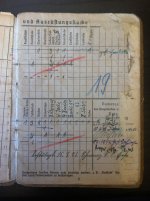 IMG_5696.jpg291.4 KB · Views: 16
IMG_5696.jpg291.4 KB · Views: 16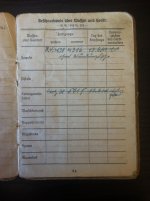 IMG_5697.jpg294.6 KB · Views: 23
IMG_5697.jpg294.6 KB · Views: 23




